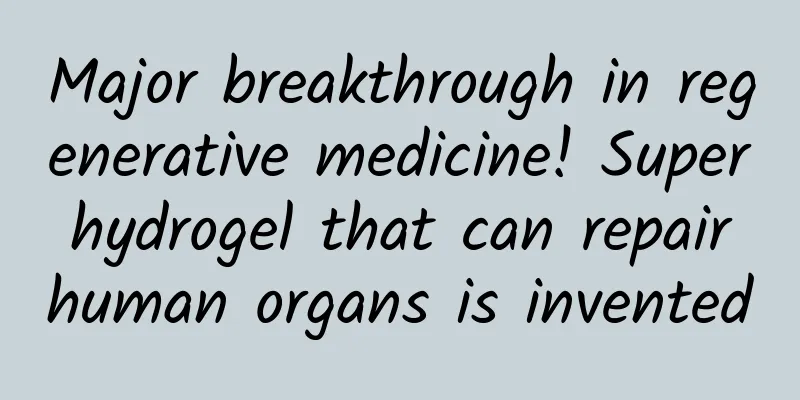Major breakthrough in regenerative medicine! Super hydrogel that can repair human organs is invented

|
If one day human organs can be repaired like car parts, can we defeat the ultimate fate of disease, aging and even death? Recently, the team of Professor Luc Mongeau and Professor Li Jianyu from McGill University developed a new injectable hydrogel for organ repair, which is called PDN (porous double networks) because it contains porous double networks. Once injected into the body, the PDN hydrogel forms a stable porous structure that allows living cells to grow on it to repair damaged human organs. The mechanical kinetic energy carried by human organs presents a huge challenge for regenerative medicine and implants. An extreme example is the vocal cords, arguably the most mechanically dynamic organ in the human body. Currently, patients with vocal cord injuries require repeated injections of hydrogels because existing hydrogel implants tend to break under dynamic loads. The same is true for a constantly beating heart. In order to verify the toughness of this new hydrogel, the McGill University team subjected it to a severe "ultimate challenge". Surprisingly, the PDN hydrogel remained intact after vibrating more than 6 million times at a speed of 120 times per second, while similar products had already been torn into pieces due to pressure. At the same time, the PDN hydrogel can support the survival of cells in organ-sized scaffolds with a size of more than 60 mm, which is the maximum value reported in the literature. McGill University said in a press release that PDN hydrogels "combine cutting-edge knowledge in chemistry, physics, biology and engineering to repair major injuries to the heart, muscles and vocal cords, and are a major advance in regenerative medicine." The related paper, titled Injectable, Pore-Forming, Perfusable Double-Network Hydrogels Resilient to Extreme Biomechanical Stimulations, was published in the journal Advanced Science on November 22. In order to better understand the principle of this biohydrogel and the story behind it, Academic Headlines English interviewed one of the authors of the paper, Bao Guangyu, a doctoral student in mechanical engineering at McGill University. In 2020, Bao Guangyu published a paper titled Triggered micropore-forming bioprinting of porous viscoelastic hydrogels in the journal Materials Horizons of the Royal Society of Chemistry in the UK as the first author, detailing the highly interconnected porous hydrogels with cell-sized pores made using bioprinting technology. In the research and development of "repairing" human organs, Bao Guangyu and other scientists in Professor Li Jianyu's team have been constantly improving. Schematic diagram of PDN hydrogel | Source: McGill University Interview Q&A Academic Headlines: Hydrogels have always been a hot topic in regenerative medicine. What are the main differences between this hydrogel and other similar products? Bao Guangyu: Human tissues need blood circulation and mechanical toughness to function. Hydrogels are networks of polymer chains that contain a lot of water. They are often used as injectable implants to repair injured tissues. However, existing injectable hydrogels have very small pores (about 10 nanometers) and lack toughness and strength (like jelly and tofu). They are not suitable for making organ-sized implants and cannot survive the dynamic environment of mechanically active tissues (such as the heart, muscles and vocal cords). The hydrogels we invented are injectable and cell-friendly. They differ from other hydrogels in both pore size and mechanical toughness. Our hydrogels have pores about 1,000 times larger than standard hydrogels. The mechanical toughness is 5 to 40 times greater than standard hydrogels. They can withstand the most extreme mechanical loads in a vocal cord-like environment without breaking, while supporting cell growth and improving therapeutic outcomes after implantation. For the first time, we have unified injectability, cytocompatibility, porosity, and toughness in a single hydrogel system. Academic Headlines: In what fields do you think this hydrogel will have significant applications? Most importantly, what made you interested in developing hydrogels? Bao Guangyu: I believe our hydrogels will help repair soft tissues with mechanical activity. They will have a longer service life and potentially provide better therapeutic effects. They can also contribute to scientific research, such as 3D cell culture in microfluidic devices (see Note). Unlike other hydrogel systems, our hydrogels can be injected into microfluidic devices without clogging the (fluid) channels. In fact, this hydrogel was designed to solve a problem in our lab. For nearly a decade, our lab has been designing biomaterials to repair vocal cords. We invented a machine called the vocal cord bioreactor, which can mimic the mechanical environment of the high-frequency vibrations of the vocal cords when humans speak. We tested many existing hydrogels in the bioreactor. They either clogged the device and prevented the cell culture solution from passing through, or simply broke into pieces after the mechanical vibrations. That's when we realized that we needed a porous and tough hydrogel to solve this problem, which provided an opportunity for this research. Academic Headlines: What makes you passionate about scientific research and development? Guangyu Bao: My passion for R&D is to use my knowledge in materials science, mechanics, chemistry, and biology to solve existing healthcare problems with engineering solutions. I am lucky to have two very knowledgeable and supportive mentors, Professor Luc Mongeau and Professor Jianyu Li. They always encourage us to focus on the world's most challenging problems and give us the freedom to explore our own research directions. My colleagues are collaborative, diligent and focused. We complement each other and enjoy brainstorming together. I love the friendly and dynamic environment of our laboratory. Experimental comparison of PDN hydrogel and standard hydrogel | Source: McGill University For Professor Li Jianyu, Bao Guangyu's mentor, PDN hydrogel is his team's latest contribution in the field of biomaterial innovation. In 2019, Li Jianyu was named the 2019 MIT Technology Review's "35 Technological Innovators Under 35" China winner for his achievements in the field of biomaterials. He was only 31 years old at the time. In an interview with MIT Technology Review, Li Jianyu mentioned that he hopes to use more biomimetic biomaterials to achieve not only chemical properties close to human tissue, but also mechanical properties and biological activity similar to healthy human tissue. He described the new biomaterial as "like jelly", with a water content comparable to human tissue, and mechanical properties similar to human tissue, or even better than human tissue. [Author's Note] Microfluidics is a technology that precisely controls and manipulates microscale fluids, especially submicron structures. It is also called Lab-on-a-Chip or microfluidic chip technology. It integrates the basic operating units of sample preparation, reaction, separation, and detection in biological, chemical, and medical analysis processes onto a micron-scale chip to automatically complete the entire analysis process. References: Interview reporter: Liu Fang Editor: HS Layout: Li Xuewei Academic headlines |
<<: Why do my joints hurt when it gets cold? Is it because I don't wear long underwear?
>>: Click here to review your 2021! What major events have you witnessed?
Recommend
China Automobile Dealers Association: Weekly analysis of the auto market from May 1 to May 8, 2022
1. Overview of the auto market this week From May...
Technology News | Research finds genetic link between fingerprints and limb development
【Today’s cover】 Recently, the Nanxi River section...
Your character determines your upper limit: Let’s talk about the self-cultivation of operators
Today is the day of the college entrance examinat...
Aspartame is classified as a Class II carcinogen. Is it really dangerous?
Introduction: Staying away from aspartame is a wi...
From China to the United States: Talking about mobile phone screen protectors
Since humans began to use mobile phones, there has...
Lao Wang from the west of the village: A training camp to teach you how to make lessons (completed) worth 799 yuan
The course is divided into 5 chapters (the underl...
Payment system design: How does Yingke guide users to pay for the anchors step by step?
Two days ago, Fu Yuanhui made her first live broa...
Case | Investment and franchise advertising cases and effect data!
Today I will share with you an optimization case ...
Do you know Xiaohongshu's operation and promotion strategy?
A friend previously left a message asking Qinggua...
Mobile Web and Apps: Which is the Future?
[[129994]] With the popularization of mobile Inte...
It would be so cool to go to work like Wu Lei every day!
Wu Lei’s cycling vlog is popular again. From the ...
Programmer Algorithm Basics - Greedy Algorithm
Preface Greed is an inherent ability of human bei...
A group of people are sitting in a small boat watching whales. Won’t the whales be annoyed?
With the relaxation of travel after the epidemic,...
10 minutes to understand the optimization techniques of information flow advertising copy
In early February, Facebook released its full-yea...
If you don’t write your resume like this on iOS, you won’t be able to find a job
In the workplace, a resume is like a storefront. ...









